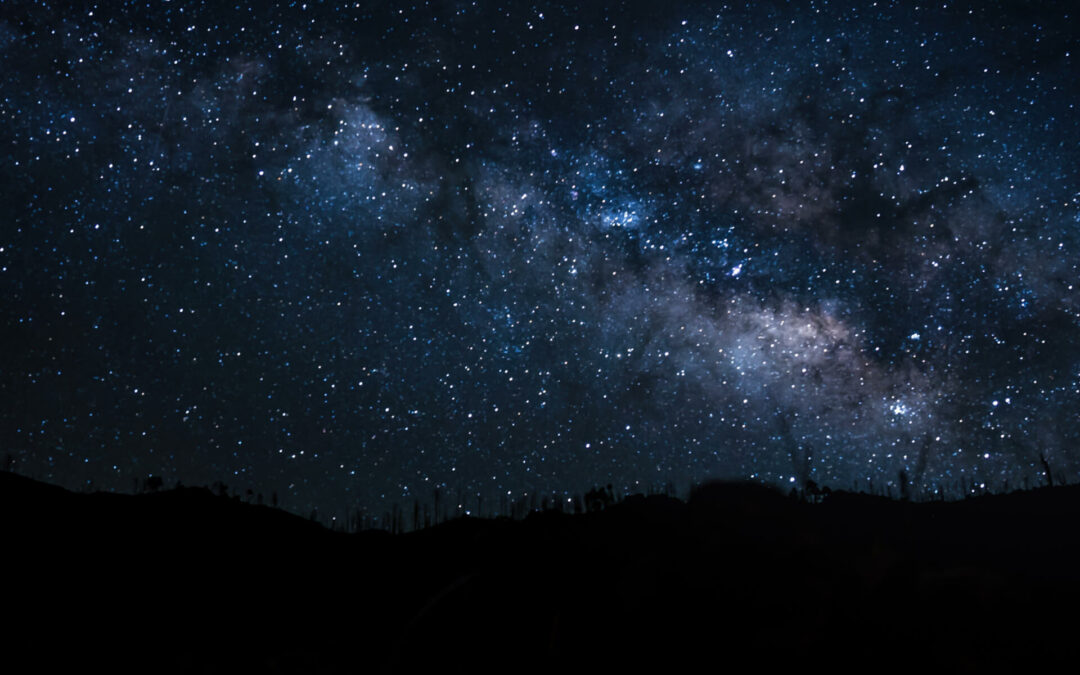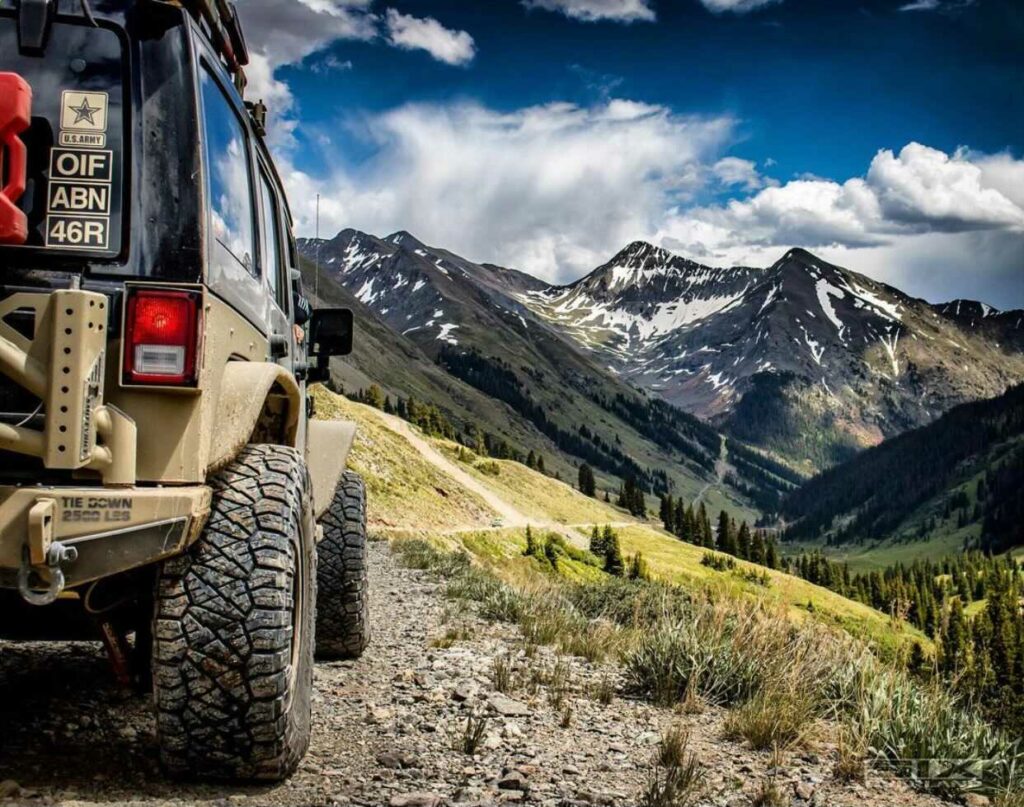How the Road Helped Heal the Wounds of War
by Jorge Gonzalez
Audio: Tracers Became Stars
Part 1: Iraq 2003
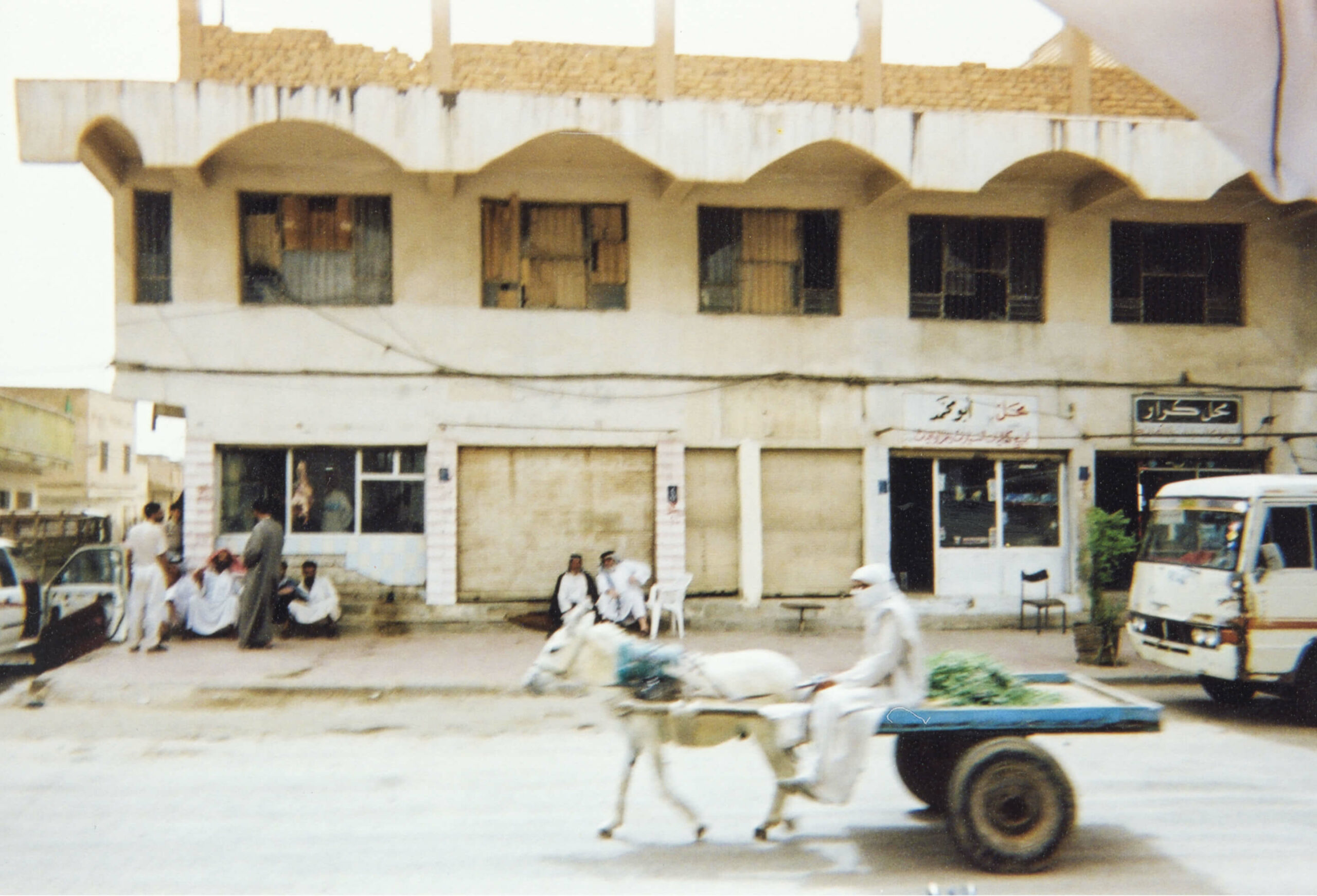
On patrol in Di’waniyah, Iraq 2003 | Image by Jorge Gonzalez
Tracers
The city was dark. Unmoving. It was past curfew, a mandate backed up by a shocking level of force. Black silhouettes of sandstone buildings contrasted against a blue graphite cosmos. One building was faintly lit, an orange blaze still consuming its guts from the previous night’s downpour of Hellfire rain. I don’t recall ever looking up at the sky, only straight ahead at the horizon where stars clung to an empty, cloudless sky, their sparkles faintly glinting through the desert haze. O-dark-thirty, Baghdad, June 2003.
“What do you think’ll happen tonight? The hajis gonna make another run at the gate?” His question hung in the hot, stifling evening air. I reached over to pick up my M4 that was leaning against the wall of our makeshift guard hut atop an old Iraqi motor pool building at Baghdad International Airport (BIAP).
“Hell if I know. I hope so. I doubt they’ll get as far in as we are though.”
“Let ‘em come.” He beckoned with his rifle.
Our guard post was less than two klicks as the crow flies from one of the many heavily guarded avenues of approach leading into BIAP. Just beyond the wall of our compound and up a narrow street was a stretch of airport tarmac where eight AH-64 Apache Longbow attack helicopters were parked in a single row. Several of them had been up and out then back a few times that day. Where they’d gone was anyone’s guess but it’s probably safe to assume it wasn’t for sightseeing.
“Oh, shit!” I exclaimed, “You see that?!” A streak of red tracer rounds from small arms fire ricocheted into the night sky, fizzling out into a background of stars dangling just above the edge of the earth.
He responded excitedly, “Ohhh, it’s on now!”
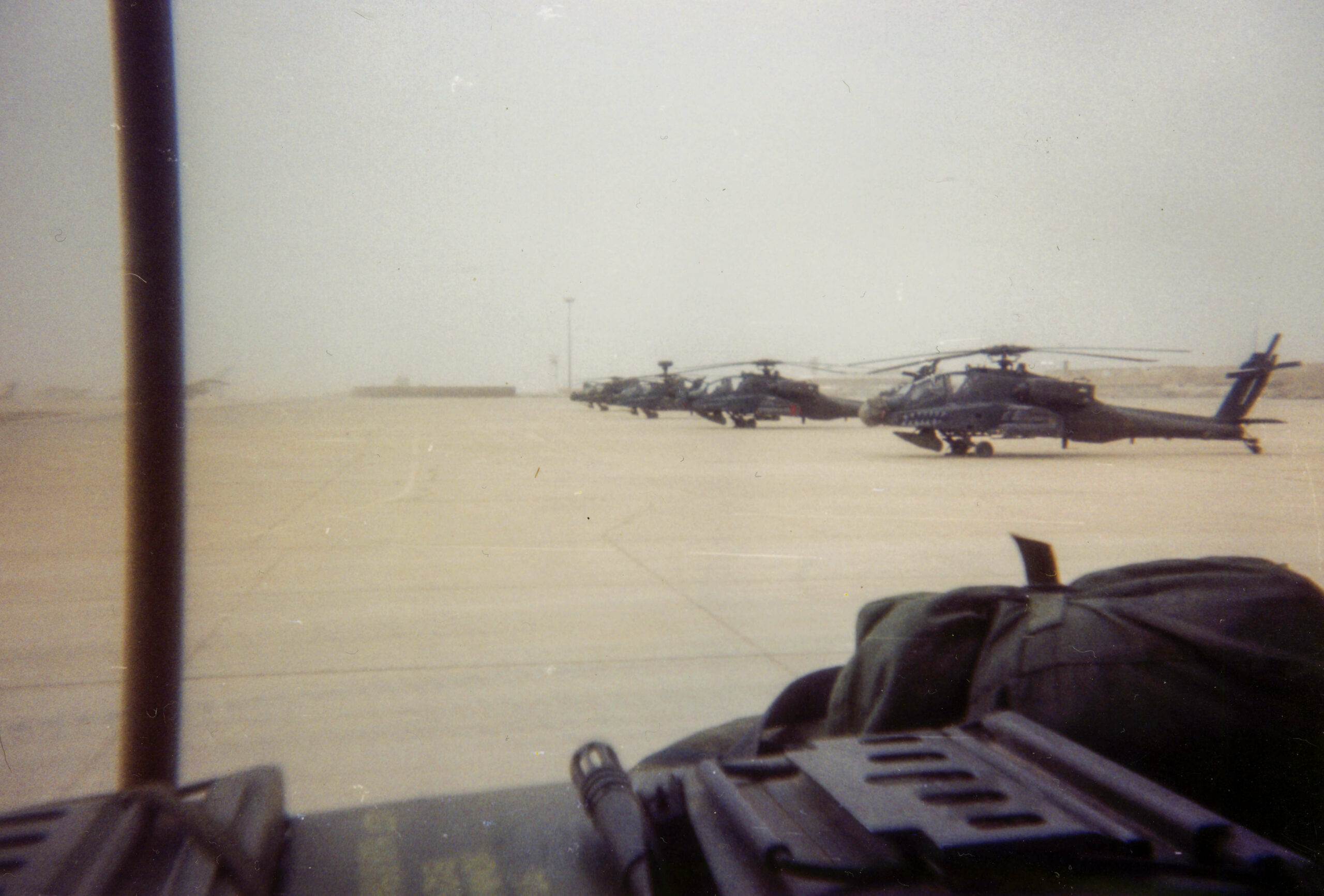
Apaches on tarmac, BIAP 2003 | Image by Debony Maffett
For the uninitiated, tracer rounds “are bullets or cannon-caliber projectiles that are built with a small pyrotechnic charge in their base. When fired, the pyrotechnic composition is ignited by the burning powder and burns very brightly, making the projectile trajectory visible to the naked eye during daylight, and very bright during nighttime firing.”(1)
A soldier loads a tracer round once every three to five rounds in their magazine in order to allow the shooter to visually “walk in” rounds on their target. It also serves as a reference for the fire team to know where to focus their fire. Several US armaments utilize tracer rounds for this purpose, from lowly infantry Joes like me to multimillion dollar Apache helicopters.
The firefight continued, the night sky flickering with fading red trails of ricocheting rounds bouncing around like demonic fireflies. The sound of Kalashnikovs and 240Bravo machine guns created a resonating sonic discord of joinder and rejoinder. Then a Ma Deuce(2) took her place in the ensemble. Chug Chug Chug goes the .50 Cal. RPGs add their own accompaniment of whistles and explosions. It goes on like this for several minutes. Additional HUMVEES speed towards the scene of the firefight.
A deafening, throttling sound appears from just over the wall and down a narrow street. Three Apaches lift off the tarmac and fly in a loop over us as they assemble into formation, their rotors pounding and swirling the still, thick air. Thud, thud, thud, thud. Damn, is it ever loud.
There wasn’t a cloud in the sky but the forecast now called for a downpour.
The Apache Longbow counts among its devastating array of armaments a 30mm M230 chain machine gun and up to eight AGM-114 Hellfire Longbow missiles (hence the “Longbow” modifier to the Apache’s name). The Hellfire is a highly effective, laser guided air-to-ground missile that imposes catastrophic damage on its targets. In addition to being carried by the Apache, it’s also one of the primary weapon systems aboard the Predator and Reaper drones. The missile that eliminated Ayman al-Zawahiri — long time second-in-command of Al-Qaeda only to Osama Bin Laden — in July of 2022, was a Hellfire missile fired from a Reaper drone.
The Apache’s silhouettes are now pressed against the graphite sky, hovering like wolves over a sick calf. The 30mm cannon aboard one of the Apaches unleashes a stream of rounds, a single red streak emitting from its nose, enlivening the sky with gleaming crimson sparks and stripes dancing wildly on a once still horizon. Orange flames bleed out from under another Apache, then a searing hiss and boom shakes and scorches the earth, rendering that same sky a phosphorescent ocean of sparks and simmering embers. The third Apache reaches down from the heavens with its own Hellfire, sending whoever-didn’t-get-got-by-the-first up to meet their 72 virgins. The concussive force of the explosion reaches out to me from across the void between this firefight and where I was sitting atop that building and punches my heart.
“Holy shit.” The excitement is now gone. All I could manage was a quivering awe and a tormenting sense that what now occupied the throbbing mycelia in my head, at the sight of this smoldering sky, was a burnt image in my psyche of red tracers crowding out sparkling stars.

Images from top left: Iraqi girl on patrol, Jorge Gonzalez | Jorge and team on gun truck, Debony Maffett | Women in abaya, Jorge Gonzalez | Jorge packing gear a few hours before crossing the wire into Iraq, Debony Maffett
After War
Did I witness this scene? Once? Twice? I don’t know. I know that it and several like it look and feel familiar to me. For years after returning from a short, tension laden tour in Iraq as an infantryman, I caught site of this particular memory in nightmare after nightmare night after sleepless night. Why this one of all the ones it could’ve been? I don’t know the answer to that either. But this scene and many others besides tore me from my bed and landed me in a narrow little closet where I laid my head to rest for more than a year next to my weapons and my wife Jessica. In that order.
“Babe,” she would say to me, through tears and down turned eyes, “you need to see someone.”
“Nah, I’m good.” I would say before returning to ignoring her, ignoring me, ignoring everything and living with a numbness I could feel was threatening to destroy my life. Until one day, when I couldn’t bare the countless needles pricking the flesh of my soul anymore, I packed a bag, got in the car, and left without a word.(3)
Something was broken. Or maybe something was in the process of delaminating, of splitting, of cracking and disintegrating. There was a ticking. Some thing that would blow the entirety of my insides apart and billow acrid smoke and fumes and flames and fury, paranoia, hatred, anxiety, anger.
Lost. Missing in action. No, worse. Here but still over there in all the ways one doesn’t want to be because when you’re over there all you want is to be back here, where life makes the kind of sense you’re accustomed to. But once back nothing makes much sense. The light that is cast over each day presents itself askew, as if the prism of reality has desaturated and become monotone, like that desert in Iraq, on the road between Safwan and Di’waniyah.
And like that road, you don’t traverse the space between all at once even though it all looks the same and feels the same, it’s 127º of relentless desert. The brain boils and the skull simmers trapped inside a kevlar bucket. Dressed in 60 lbs of bullets, grenades, steel plates, and an M4, you wonder why you’re even here. The only way back is deeper into this shithole, the only way forward is to remember you signed the dotted line thinking this was all for something bigger than yourself only to learn when the first bullet wizzes overhead, while sitting completely exposed on the back of a HUMVEE, that your life, like the masses of men in ages before you who’s meat and bones and spirits were lost to the acidic vomit of war that you are nothing but the smallest, most insignificant cog in a machine that has no idea what it’s doing; only that it must continuously kill to justify its own existence. Boys like me, at that age, find it enchanting, we find it adventurous, we think it’s where meaning and fortune are found. Some find it. The price paid is measured in fragments of shattered Soul.
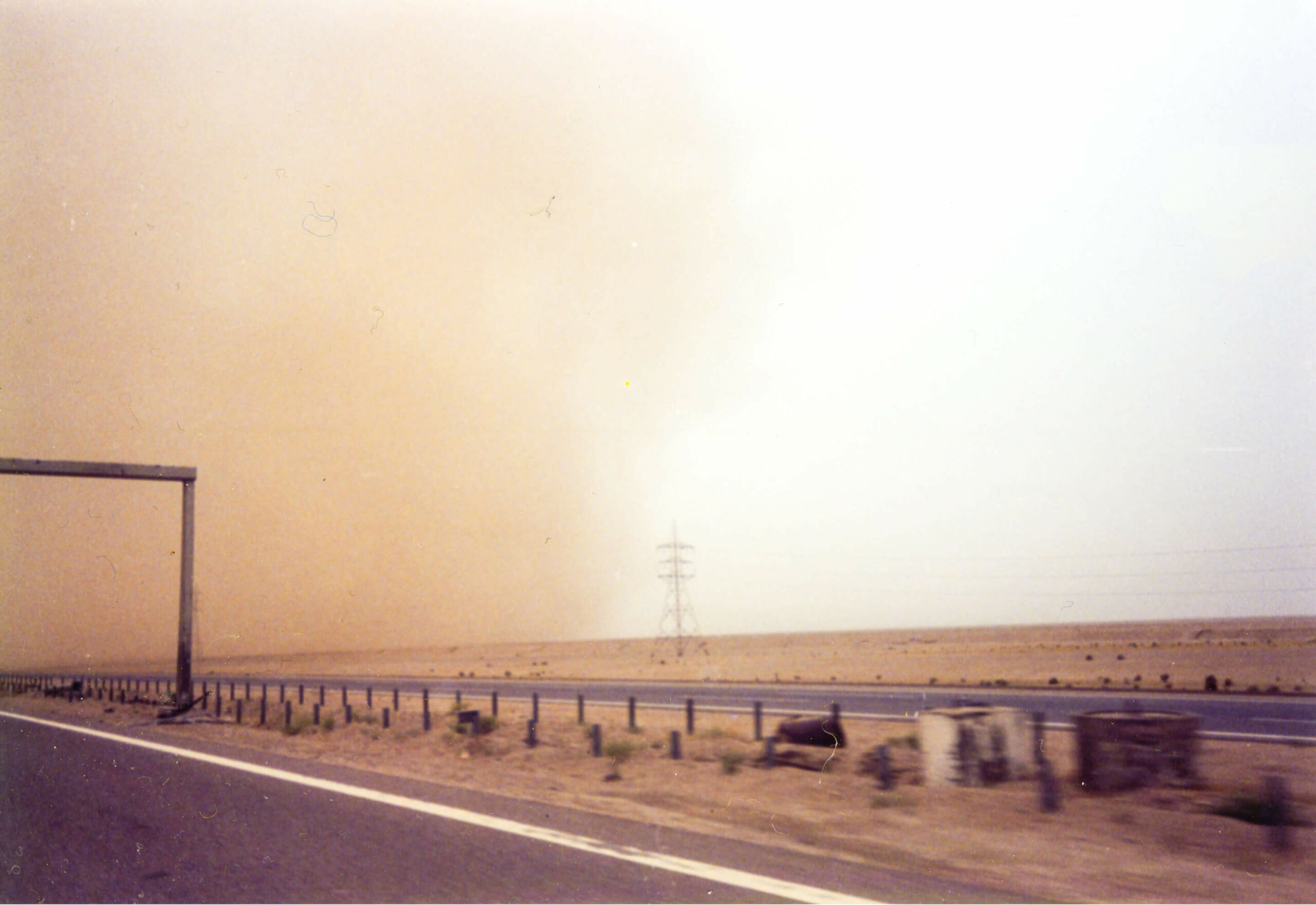
Incoming sandstorm, Iraq 2003 | Image by Debony Maffett
What a waste. Because when the battle rattle is shed and you arrive back to where you desperately wanted to return, you realize something is definitely ticking. Something in that monotone desert is still stretched out in front of you even if you can’t quite place it. I had no idea how to handle it, how to assess it, how to examine its contents because it had only the faintest ephemera even while displaying the clearest symptoms.
Months passed. The ticking grew louder. Years passed. Metal ground down metal, until finally the lubricity of ignoring it all evaporated, inviting an explosion whose fragments pierced and rusted in my flesh for nearly two decades.
When it happened, when I couldn’t hang on anymore to the illusion that I was fine, I disappeared without a word for a week, and when I came back, I finally told Jessica what letters written home had failed to convey. Iraq: a tangled wreckage made of sweat, sand, a chambered round, a boy’s face, a recurring nightmare about incoming mortars and explosions and Apache rotors throttling a cloudless night sky, launching hellfires into palm trees and alley ways, and plenty more besides. There’s the cowardice and the bravery, the guilt and regret, night terrors, wholly disproportional rage laced outbursts over nothing. Though I went through the motions of life, those who loved me most felt the most distant to me. I couldn’t connect. I didn’t belong. Something was wrong. The Military insisted I was fine but something was wrong.
Still unable to shake myself loose from nightmares and dalliances with a 9mm pistol, I was admitted into the psych ward at the Veteran’s Hospital. In a pallid green room, brightly lit as if by phosphorus torches, I told them of my struggles, my combat themed nightmares, my suicidal ideation, the guilt I felt over memories who salience I couldn’t dilute. Even then, I was told all I suffered from was “Single Episode Major Depression.” That is, what I’d been experiencing for years was a singular episode of being down in the dumps. Seriously? I wondered. They shoved two bottles of pills at me, gave me a “therapist” whose treatment model was to have me color in books with old crayons, and wished me well.
All the drugs did was make me numb, only now the numbness was absolute. At least before, when I was not in a state of derealization, I could feel anger or disappointment, joy and gayety even if the poles between those were extraordinarily tall and compressed oscillating waves. But now, these pharmaceuticals turned me into a hallucinating zombie.
Some months after my time in the hospital, desperate for a change, and for a break from the monotony of pill laden days, Jess and I took a trip around the American West that would change me forever.
Part 2: 5158.3 Miles
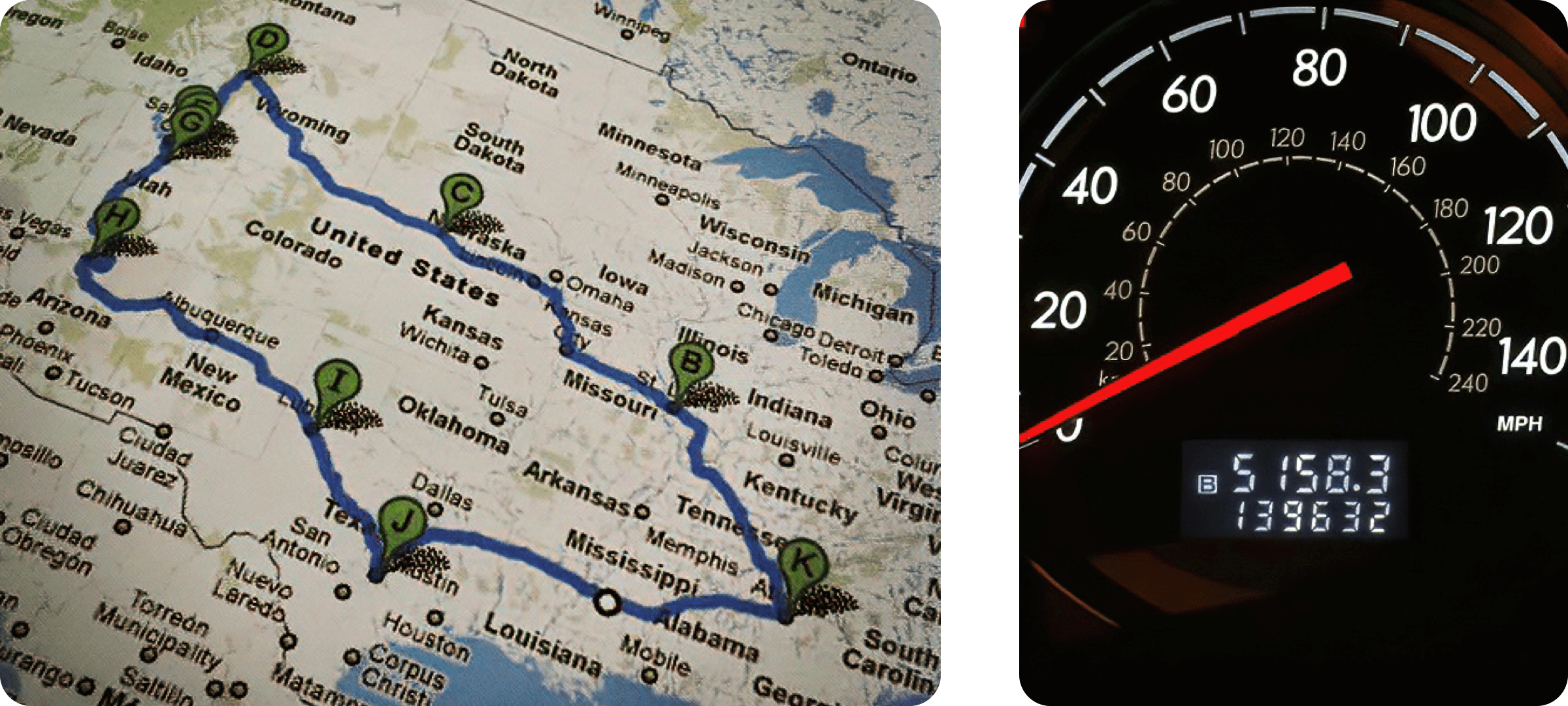
Our planned route and odometer upon returning home from our first trip around the West
The Tetons
We hit the road west bound from Atlanta in early March of 2012, almost two months after I’d been admitted into the psych ward at the VA. The road took us through multiple states we’d never visited. From Atlanta, we headed north and west passing through familiar Tennessee and less familiar Kentucky before reaching unknown Illinois and then onto the newness of Iowa, Nebraska, and Wyoming. All were alien to us. The sheer size of places like Wyoming staggered our imagination. I had no idea what this road trip would crack open in me.
“Mountains, Gandalf! Mountains!” Jessica – quoting Bilbo’s exclamation to the wizard Gandalf in Tolkien’s Lord of the Rings – let out a whooping yell at the first site of the Rockies. We’d never seen mountains like these before! We were two Southern kids who’d spent summers in Appalachia but get real, those may be mountains according to geology; the Rockies, however, are mountains of a whole other order.
And then the Tetons! Standing in front of them we were transfixed by the sheer size of the rocks that reached up towards the sky. To that point in our lives, we’d never born witness to the majesty of America’s purple mountains, rising as they do above the fruited plains of the West.(4) The flatness that flanks the mountains on the east and west rises up instantly to form huge ranges of gray, brown, and blue rocks painted with shimmering snow and reaching up more than13,000 ft leading the eyes skyward. I’d never seen nor felt the presence of something so powerful, so grand as that vista. Something inside whispered, not quite a voice but neither was it purely a feeling. It took on the form of a faint echo, reverberating through a secret valley in my emerging soul and therein I sensed that these vistas were a reflection, sights speaking in Mysterium, “This exists within you. What you’re after is there.”
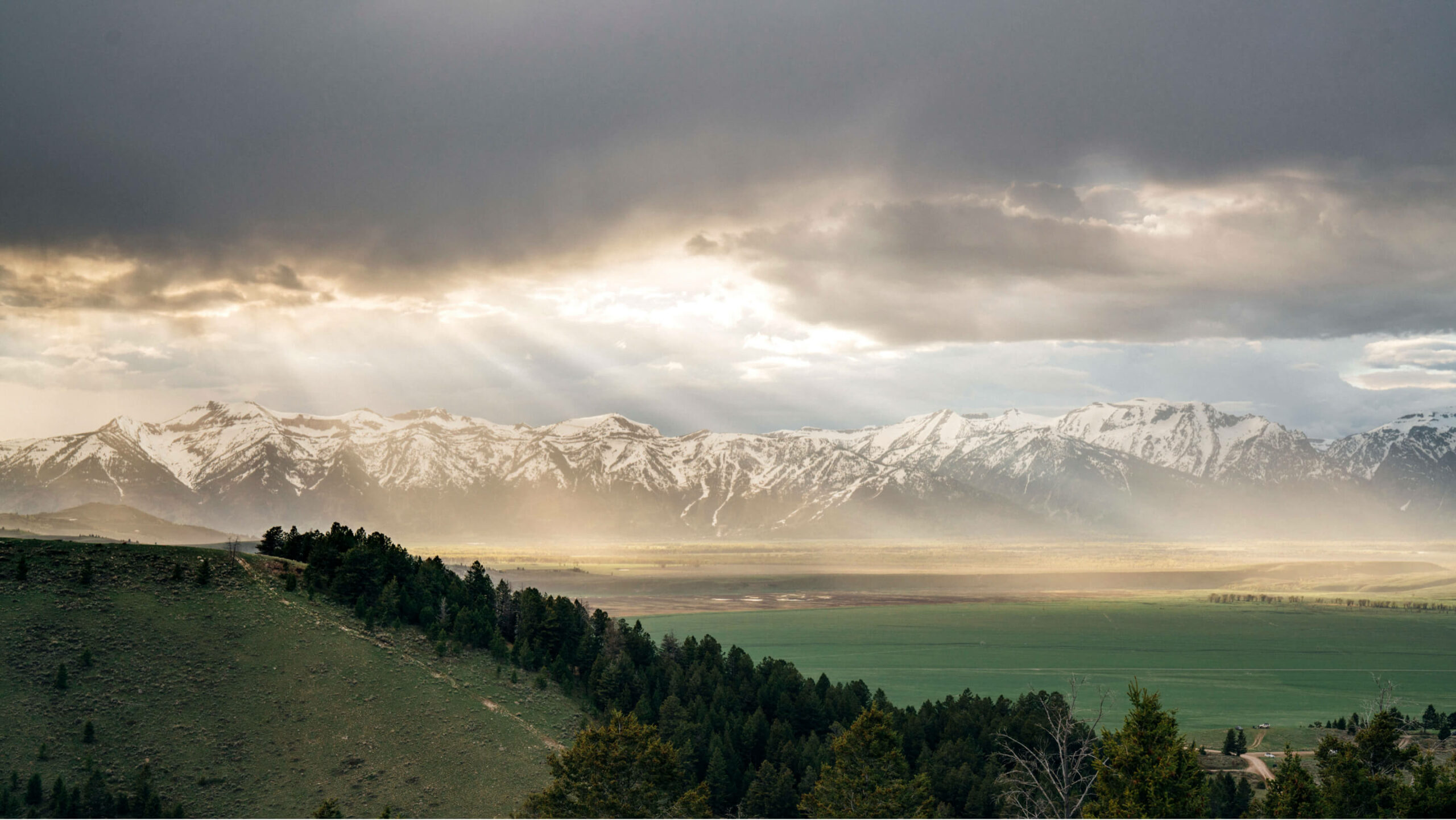
The Teton Range | Image by Jorge Gonzalez
My roiling inner states, the ones that drove me to nightmares and vanishing from home, appeared to me then as mere nuisances. The quiet of the land, the size of the sky, the colors spread over the earth’s surface all danced together in a seamless flow, as if it all belonged together with me and me with it. Even at the end of winter, where grasses were dressed in brown and splotches of snow and ice dotted the land, the scenery nevertheless held me in an entrancing wonder. This interplay of heaven and earth hinted at what wholeness could look like, could feel like. There was something in the sunsets and how they painted the flat stretches of open land, how the sky met the earth endless miles away from my center of awareness, and then to see the Tetons rising from the land not in a gradual soft grade but nearly all at once! Language falls short.
The little window through which I’d experienced and filtered the world up to that point was widening and I longed to step through and out of it. I wanted to embrace a new vision and way of thinking but I still felt sewn to my past, unable to integrate the vastness of the experience into something resembling coherence. But here, now, standing in front of the Teton Range I quivered, as if being scraped by a glacier, my spirit being formed and chiseled by the pressures of time, force, and awe. The shadows of the Tetons stretch out over the earth, covering all assembled there in a soft, blue cast. Trees adorn their granite slopes reaching up to barren rock and hardened snow, and once at the top, the Teton peaks themselves rush to meet the sky, steeples pointing the way to the heavens within. In the face of this scene, my mind sat quiet, hypnotized. I held Jessica’s hand and all at once an awesome Peace that passes understanding fell over me.
The Festival
Behind the wheel again, I wondered whether something out here held the secret to calming what had been swirling in my head. Could it be as simple as driving from place to place? It certainly appeared that way.
After our time in the Tetons we pointed the Subaru south and headed to Spanish Forks, Utah where we attended The Festival of Holi at the Sri Sri Radha Krishna Temple.
Nestled in the shadow of the snow crowned Utah rockies, the temple grounds were home that day to thousands of festival goers. The crowd was swaying and undulating in rhythmic unison to the music emanating from the stage where a band was playing some kind of rap/Indian/ska/reggae/rock/sitar music. From time to time, a puff of color would ascend towards the sky and descend in a diffused cloud onto the dancers below. Sometimes blue, sometimes purple, sometimes green. Four thousand people all moved in rhythm together to the music and the chanting of the Maha Mantra.
hare kṛiṣhṇa hare kṛiṣhṇa
kṛiṣhṇa kṛiṣhṇa hare hare
hare rāma hare rāma
rāma rāma hare hare
Supposedly this chant creates some kind of extra sensory vibration that in turn provides clarity and cleansing. Don’t hold me to that interpretation. That’s just my recollection of what I was told it meant. At any rate, chanting it worked everyone up into a lather and filled the place with good vibes.
Every two hours or so it would happen. A robed man would get on stage and grab the microphone. After delivering his message of peace, unity, and love, chanting the Maha Mantra with the mostly white-shirted Mormon college student crowd chanting along, he would start the count down.
At 3 the crowd’s voices swelled and the throng undulated in preparation, at 2 a few people too excited to wait until 1 prematurely released their bag of powder, at 1 a crowd of three or four thousand people all over the temple complex threw a rainbow of colored powder up into the sky, all of the colors mixing and diffusing into a dusty cloud that then fell onto the multitude of smiling, dancing, giggling, hugging festival goers below.
It was the Festival of Holi: the festival of sharing Love. The music, let’s be honest, was shit but it didn’t matter. On they danced, their white shirts now grayish blue from all the powders mixing into the fabric.
The colors floating in the air that day were a far cry from the disquieting green hue of the psych ward a few months earlier. And though for years I’d shied away from being in crowds because of experiences I’d had in a market in Iraq, here I felt calm and as One.
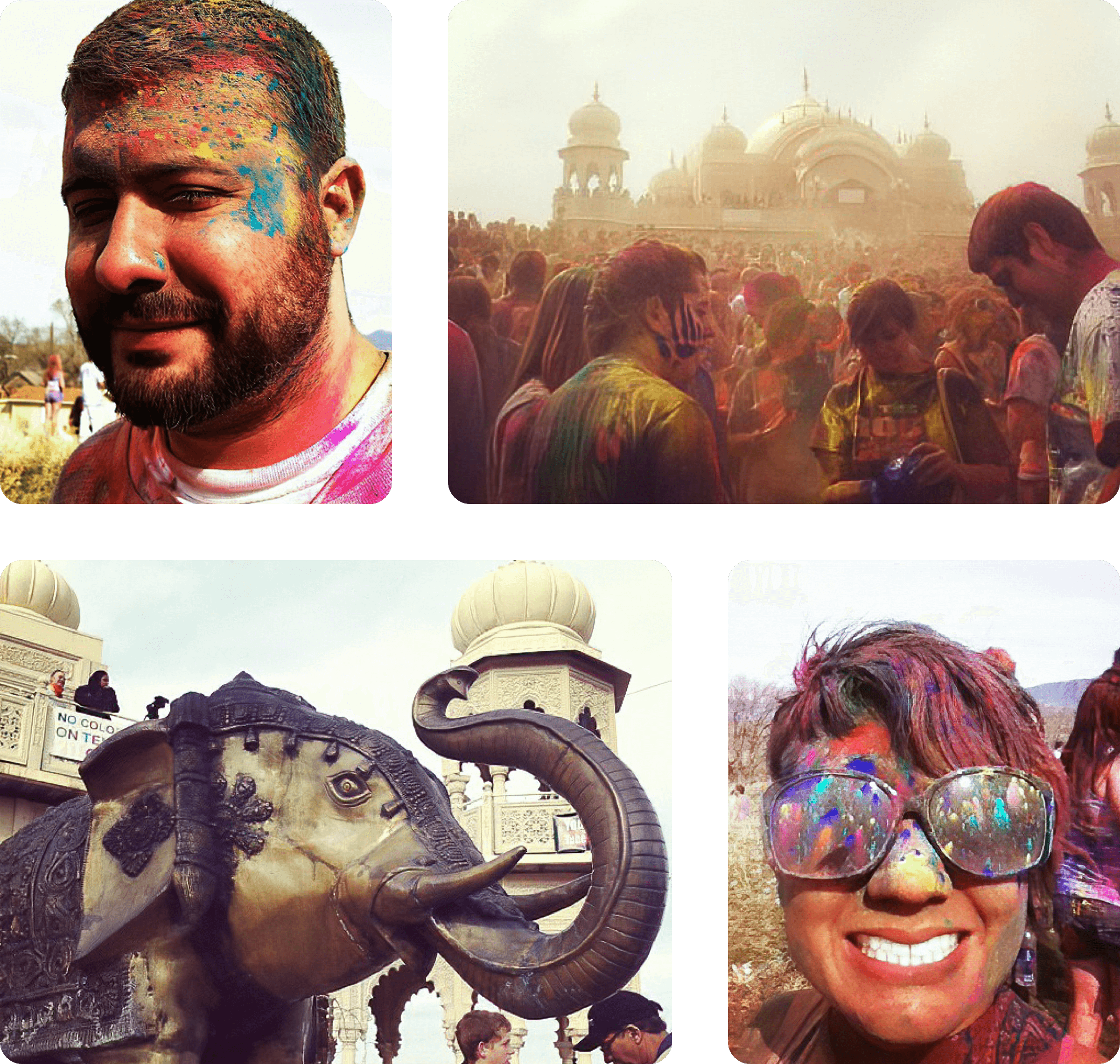
The Festival of Holi, Sri Sri Radha Krishna Temple, Spanish Fork, UT 2012
Four Corners
After the festival, we made tracks to southern Utah to visit Arches National Park. Seeing all the red rocks, mesas and red desert for the first time left us spellbound. So spellbound, in fact, that I looked away from the red, wind hewn rock faces to see a State Trooper with his spinning blue and red lights following closely behind us in my rearview mirror.
That ticket was not cheap: eighty in a sixty-five? Ouch. It’s never fun getting pulled over, but the magic of that place was still in the air, captivating me, us, in its flaming red spell. We had no idea that these Wile E. Coyote landscapes were in Utah. For whatever reason, we’d always thought they were in Arizona!
The land around us catches fire. It glows red, pink, and orange, painted by the brush of the setting sun, when we see a sign to the Four Corners Monument. We’d heard of Four Corners before but weren’t entirely sure what it was. I figured it was a patch of dirt with one of those plaques you see marking a historical place or pioneer route.
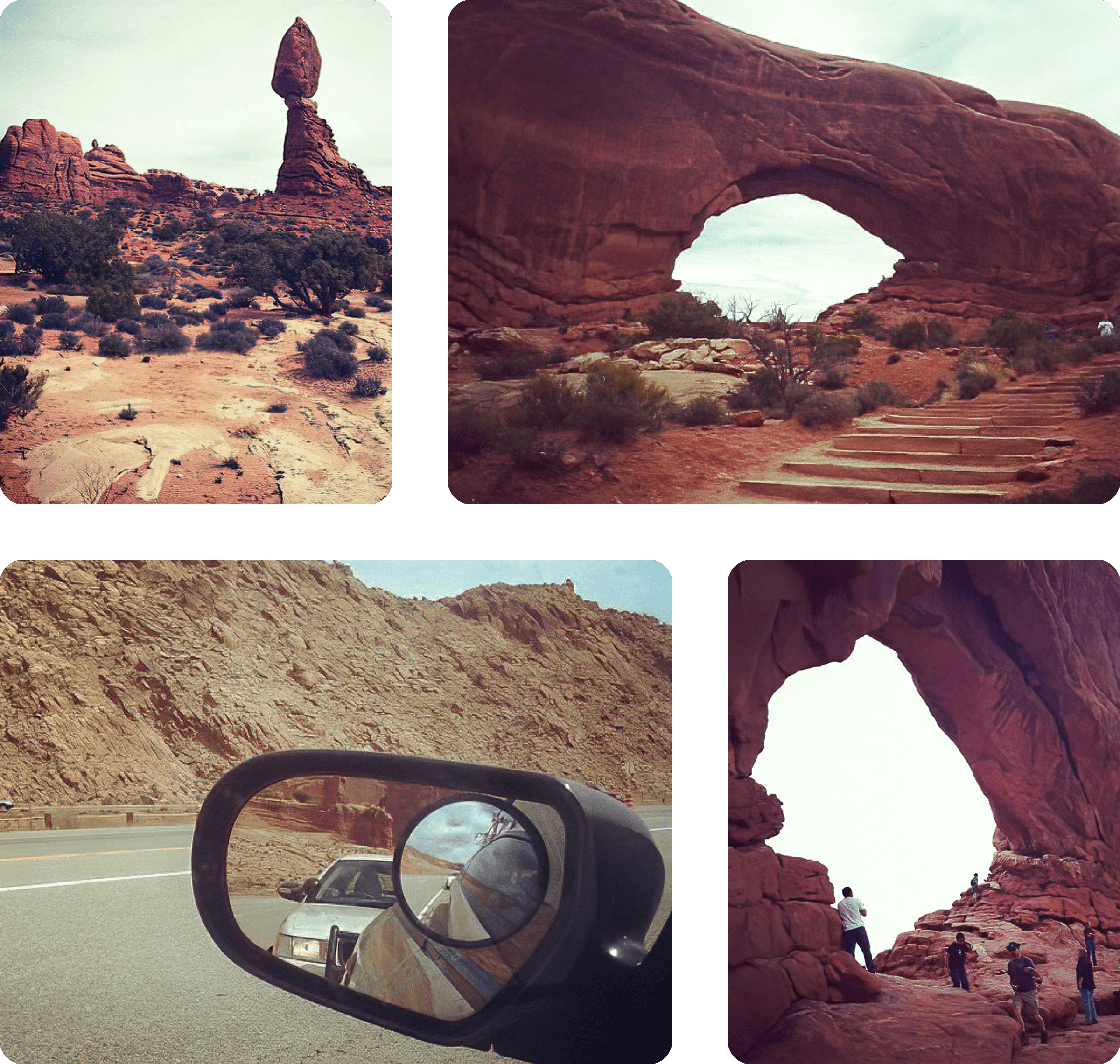
Exploring around Arches National Park and getting a speeding ticket outside Moab.
We turn down the road to go for a visit. Twenty minutes or so later we arrive. It’s not a plaque or some patch of dirt one can just saunter to apparently. It’s fenced off, has an entrance gate, a road going to it, it’s on Navajo land, and much to our dismay, it’s closed. This being our first experience in the West with these sorts of Monument areas, we had no idea that some close at 5pm.
It’s dark now, the brightest stars in the night sky are beginning to twinkle through the fading light of dusk. Some RVs pull up, the occupants are equally disappointed that the place is closed. Jessica walks to the entrance gate and down the fence line when she calls me over to her. She’s on the other side of the fence! Navajo territory! She points at a large hole in the barbed wire and says we can squeeze through and ride our bikes to the Monument.
Emphatically I proclaim, “No! No way! It’s dark, it’s the desert, there are coyotes, wolves, Navajos, the gubment…No!”
But like the stars emerging in the night sky, Jessica’s eyes are twinkling. I sense a deviousness, a mischievous modulation of energy carried in on the wind. Adventure is afoot. She comes to the other side of the fence to remove the bikes from the car.
“You gonna help me or what?!” She demands. I’m still firmly against this scheme of hers but my concerns fall on deaf ears. Over the fence go the bikes. We squeeze through the hole she discovered and set off down a pitch black road towards the Monument.
The ride is maybe a quarter mile. The entire time I’m pretty nervous, scared to be breaking the rules, because you know, “Dress right, Dress!” and all that. Jessica, however, is having a blast, laughing, chattering, and admonishing me to keep the iPhone flashlight pointed at the road. We can hear the clinging and clanging of the flag poles chiming, inviting notes into the night sky. Dancing in the wind are Arizona, Utah, New Mexico and Colorado’s flags flapping, folding, unfurling around the Monument. Jumping off our bikes, we run to the center where the four states meet. Jessica is whooping and hollering, howling, making a wild ruckus. I’m quiet, still certain we’re gonna get arrested or mauled. She takes me by the hand and pulling me toward her small body hugs and kisses me on my nervous mouth.
“Just breathe it in, babe! Howl with me!”
She howls again, I howl with her. She takes a spectacularly shitty photo of the meeting Corners and then yanks me by the hand toward the bikes. Pedaling off into the dark back to the Subaru I find myself possessed by thrill, captured by a constellation of wonder at what has thus far transpired. Something free happened here, something wilder than I’d ever considered we were capable of. I know this is small potatoes, we’re no Thelma and Louise, but this, this was different! That night I got to see a side of Jessica I had never experienced before: her wild, free, uninhibited spirit yanking me towards the unknown, towards adventure, towards discovery and freedom, inviting me down a dark black road. I hadn’t let go in years and as a result I hadn’t given her the space to do so either.
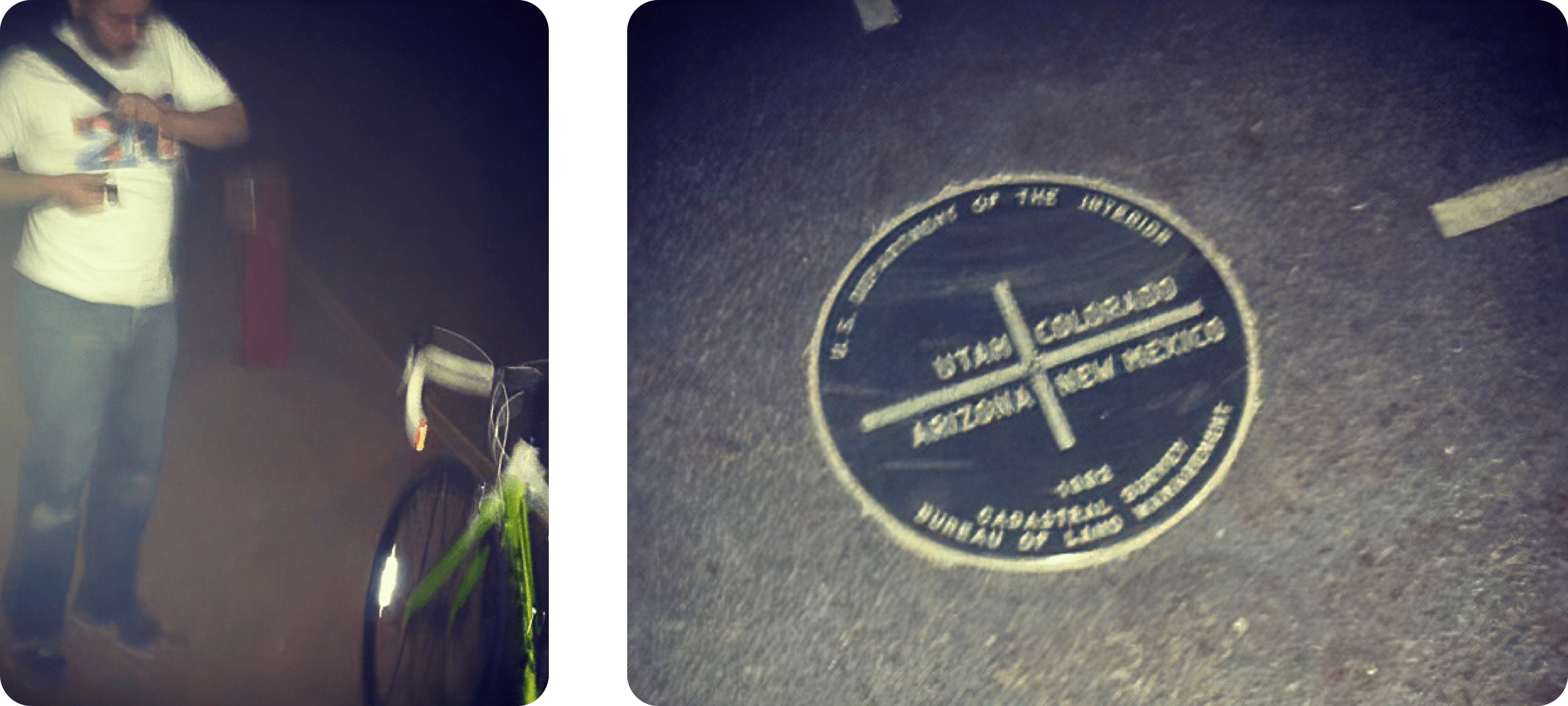
Getting ready in the dark | Spectacularly shitty photo of Four Corners
The Tetons, the Festival of Holi, the experience at Four Corners, and driving around the West was what began the ignition sequence that would eventually launch us out onto the open road. We found a certain peace out here. For me, it was a peace that I’d not felt since the halcyon days of my early childhood. Every new mile invited moments of reflection and quiet. The road was a place I had long avoided. Flickering memories where I was riding on the back of a gun truck through narrow streets in Di’waniyah and Baghdad wearing sweat soaked desert camo, my thumb on my M4’s selector switch, cautiously gauging every alley for movement, every concrete building’s open window, viewing each overpass in anticipation of an ambush, and enduring several pot shots taken at my exposed body became distant recollections. The more miles I put between me and them — those memories, those streets — the less immediate was their enveloping fury.
After Four Corners, Jessica and I pressed forward, crossing new state lines, bearing witness to endless expanses. We reveled in the constant movement, the fresh scenery, the quiet stillness of the desert. On the horizon, I stared at billions of stars rising over the black silhouetted landscape, the site etching itself into my psyche replacing those nights I spent on guard watching Apaches light up the night sky with tracer rounds and Hellfires.
Here in the darkness of the deserts in Utah and New Mexico, coyotes howled, the breeze blew through creosotes filling the air with the sweet scent of earth, the land rested in still solitude at the edges. Tracers became stars and a sense that Love is the essence of Reality crept ever closer to becoming revelation. Thereafter, I threw away my pills and took my first step towards becoming whole once more.
Eighteen months later, on a cool night in Austin, TX we loaded up the first of many overland rigs, our eyes set on the horizon where over the next eight years, sunsets promised new perspectives and night skies invited careful consideration of consciousness and its myriad contents.
Part 3: Final Thoughts
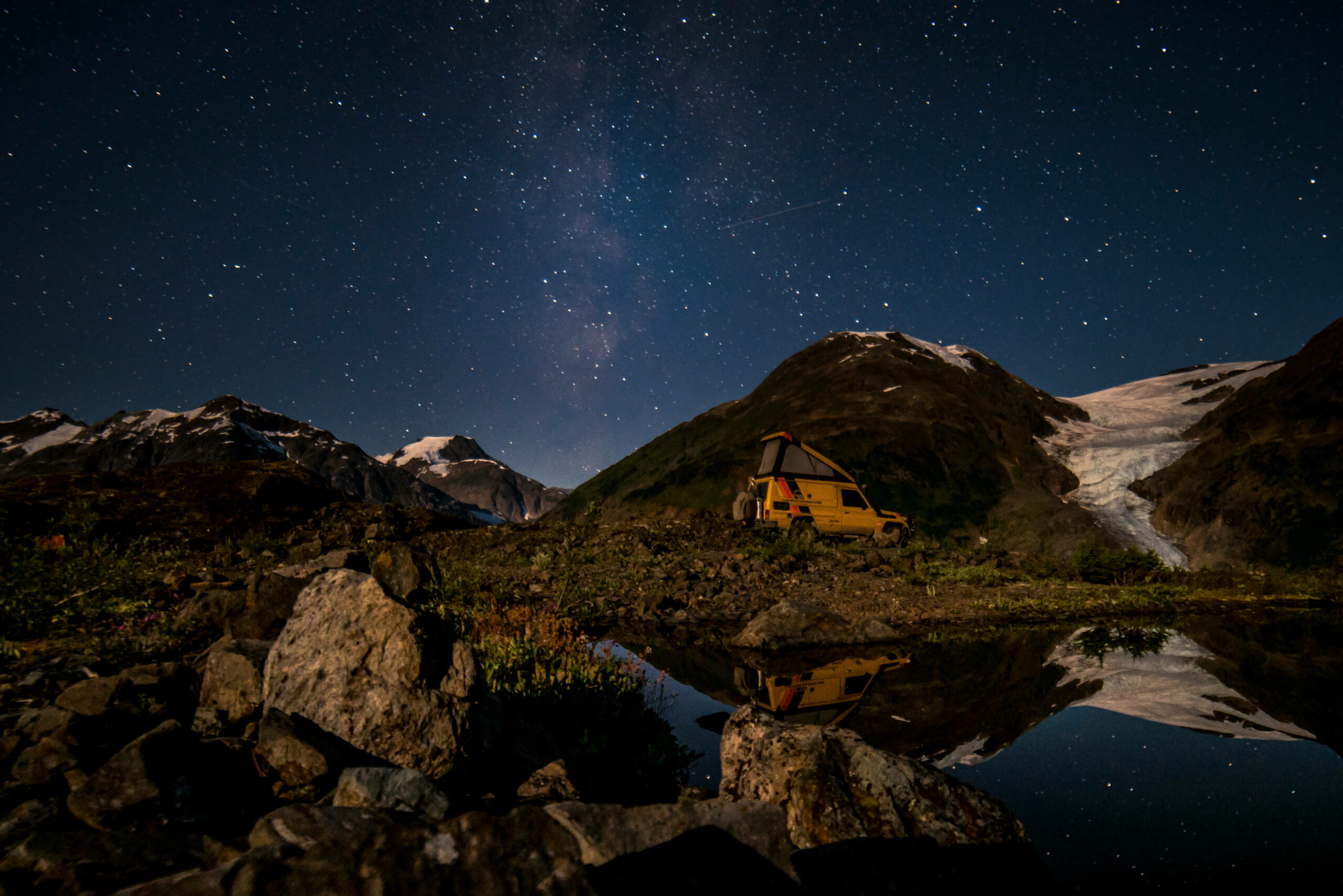
Camping at Salmon Glacier, British Columbia | Image by Jorge Gonzalez
A Stoic’s Advice
I am reminded, in sharing this story, of the Stoic philosopher Seneca’s admonition to travelers seeking to use travel as a modality for healing the soul. He writes,
“What good has travel of itself ever been able to do anyone?…It has never controlled the temper of an angry man…never in fact has it rid the personality of a fault…All this hurrying from place to place won’t bring you any relief, for you’re traveling in the company of your own emotions, followed by your troubles all the way….You need a change of soul rather than a change of climate.”
Methinks Seneca doth protest too much all the while hinting at a truth I discovered in the eight years we spent living out on the road. He’s right that one travels in the company of one’s own emotions, one’s demon(s). I know this dynamic well as the wreckage of several relationships made and broken in the time I spent on the road will attest. What I have thus far offered in this story is, in many ways, no more effective than the drugs the VA prescribed me.
No, indeed, for the fragmented soul, the road often becomes a panacea, an escape. Eventually it inverts and fractures whatever fragile peace one has managed to discover from initial encounters with the numinous(5) (like what I experienced that first time at the Tetons). Travel can give you a break from the cycles of rumination and desperation, but it ain’t gonna do the work for you. In the time I spent meandering across North America and parts of Western Europe, I met several other travelers similarly committed to using new places and new experiences to hide or escape, suggesting overlanding had made them whole all the while drowning in the bottle or endlessly looking outside themselves for a measure of validation and personal fulfillment. Turns out, travel, like everything else in life, has a shadow and there is no Land Rover(6) or Land Cruiser that can outrun it.
What finally ended our time on the road was a face to face confrontation with my own demon on a beach in Baja. I realized then and there that no new vista, no additional miles, would suffice to quell what this figure – what this internal struggle – demanded of me. Overlanding had played its role. It had put enough miles between the past and the present to give me the opportunity and space to embrace something new. Those eight years put me in proximity to what I now know in my bones is internally possible. Standing in the presence of the sublime enormity of so many heart stopping vistas, that sense welled up from within, through cracks made in the edifice of my ego that permitted a new light to seep through.
It took a while. It took several vistas from the Tetons to Salmon Glacier, from the coast of the Arctic to west coast of Ireland, and it required not just travel with-out but a journey within, guided by good books, mentors, therapists and not a few entheogenic experiences. What eventually transpired was me coming home to my Self where those rusting fragments in my skin have finally begun to heal over, leaving behind still tender scars. To heal, I needed wisdom, and wisdom, it seems, came from the experience of a steering wheel in my hands.
And what now of the night sky replete as it is with its endless glimmering stars hovering over a clear horizon? I turned my face finally upwards and discovered that the heavens are a reflection of the infinite, wondrous expanse within the Cosmos of my Soul.
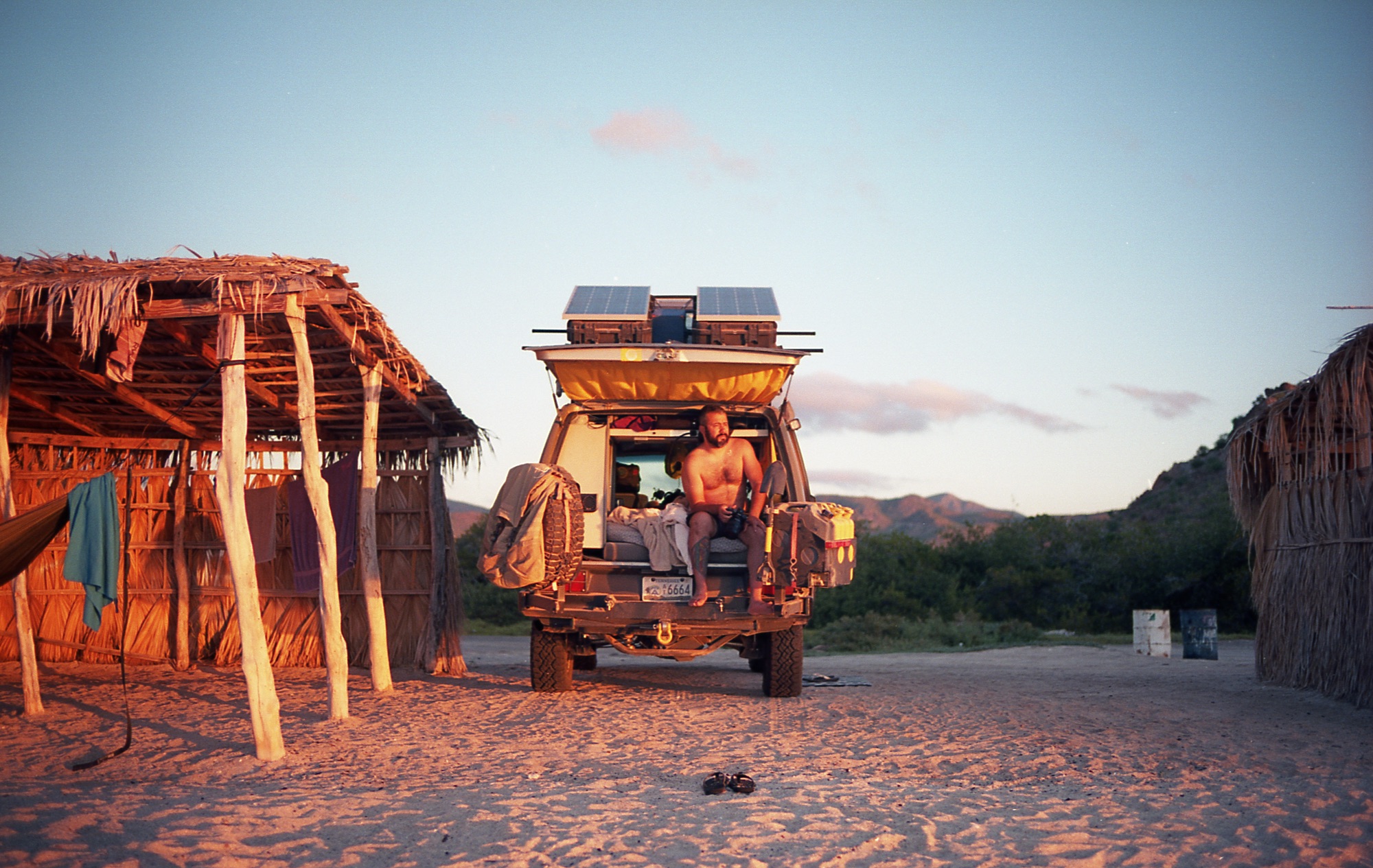
Bahia Concepcion, Baja California Sur | Image by Aidan Klimenko
The trip that started it all
Wandering Warriors
Veterans and First Responders connect on our Forums
We invite you to visit the Wandering Warriors section of our Forums to connect with other Active Duty, Veteran, and First Responder Members in the Overland Bound community.
(1) Wikipedia: https://en.wikipedia.org/wiki/Tracer_ammunition
(2) “Ma Deuce” is a military colloquialism for the air-cooled, belt fed Browning M2 .50 caliber heavy machine gun.
(3) This experience, I would later learn, is known as Derealization. Derealization is an alteration in the perception or experience of the external world so that it seems unreal. Other symptoms include feeling as though one’s environment is lacking in spontaneity, emotional coloring, and depth. It is a dissociative symptom of many conditions including severe stress, trauma, depression and anxiety (Wikipedia).
(4) From the poem Pikes Peak by Katharine Lee Bates, which later became known as the song America the Beautiful
(5) Numinous: descriptive of persons, things, or situations having a deep emotional resonance, psychologically associated with experiences of the Self. “The numinosum is either a quality belonging to a visible object or the influence of an invisible presence that causes a peculiar alteration of consciousness.” Psychology and Religion, CW11, par. 6, Carl G. Jung [Reference taken from https://carljungdepthpsychologysite.blog/2020/05/26/carl-jung-on-numinous-lexicon/#.Y2q0Ii-B0eY ]
(6) Especially not a Land Rover…or a Vanagon Syncro. 😉

